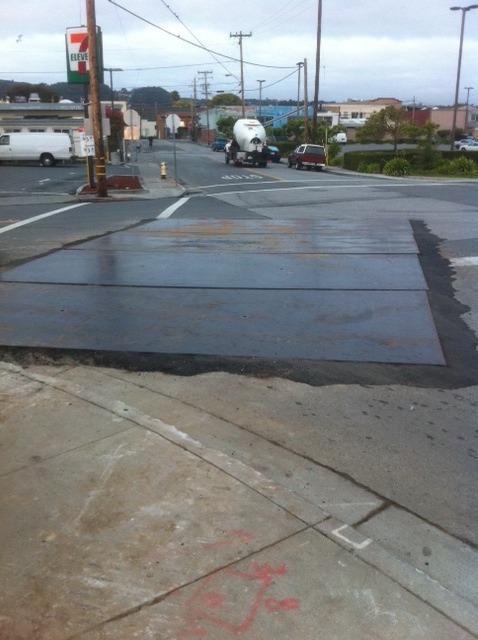Road Plate Steel Fundamentals Explained
Wiki Article
Steel Road Plate Can Be Fun For Everyone
Table of ContentsSteel Road Plates Fundamentals ExplainedExamine This Report about Road Plate SteelHow Steel Road Plates can Save You Time, Stress, and Money.All About Steel Road Plates
Box culverts are economical due to their rigidness and also monolithic activity as well as separate structures are not called for. It is used in unique situations, weak structure.Common compaction demands for a project may vary from 90% to 95% of standard Proctor for non-structural locations to 98% or even more of customized Proctor for greatly packed pavements. Proctor examinations are soil moisture-density relationship tests that establish optimum dry thickness (the system weight of the dirt minus the weight of water) and the maximum water content for dirt examples.
Water is included to 4 to 6 portions of the dried soil example in raising quantities. Each ready portion is consolidated right into a compaction (proctor) mold and mildew with a Proctor Hammer or Mechanical Soil Compactor and after that is evaluated and dealt with for moisture web content. The completely dry thickness raises as the included dampness lube the dirt bits and enable greater compaction from the exact same used energy.

How Steel Road Plate can Save You Time, Stress, and Money.
Density and wetness results are plotted against the initial lab contour to confirm a suit. In circumstances where laboratory details is not available, the field point results might be contrasted to a family members of contours put together from neighborhood or regional dirt information to select the best optimum density and also optimal moisture contour.A soil compaction examination utilizes among numerous approaches to measure the completely dry density as well as wetness content of the dirt in place. The 3 most typical are discussed right here - road plate. Arise from these area tests are compared to the Proctor test results of the same soil established in the research laboratory as well as the ratio is shared as the percent compaction.
1ft (2,830 g/cm). Density examination accessories such as clubs, scoops, blades, and example bags are utilized throughout excavation. All the excavated product is meticulously accumulated as well as saved in a closed container. The pre-weighed Sand Cone Density Device is inverted onto the base plate and the steel cone is snuggled into the base plate opening.
Afterward, the partially loaded apparatus is considered once more, and also the quantity of the test opening is calculated by dividing the mass of the sand loading the opening by the mass density of the sand. The wet weight of the recouped dug deep into dirt is separated by the examination hole quantity to figure out the damp density.
5 Simple Techniques For Road Plate
The percent compaction for the field density test is computed by splitting the dry density of the dirt by the optimum dry density from the proctor examination. Pros, Cons, Accurate as well as trusted; a lengthy history of approved usage, Tests might take thirty minutes or more to complete, ASTM basic test method, Heavy tools in the location may need to pause procedure briefly, Does not require substantial training, Alternative examinations need to be used where muches of +1 - steel road plate.
The examinations are a little bit less complex to perform than the sand cone and can be repeated rapidly considering that the water is maintained in the vessel. Pros, Disadvantages, Accurate and trustworthy; a long history of approved usage, Tests may take 15-20 mins or even more to finish, ASTM conventional test method, Balloon membrane layers can puncture during testing, Does not need extensive training, Meant for fine-grained or granular dirts without significant quantities of crude product, No licensing or allowing needed for usage, Need to not be used to check soft saturated, extremely plastic soils, Several examinations can be executed without transforming density media, All dug deep into product must be carefully eliminated, Devices is affordable Wetness material and system weight need to be performed on maintained dirt examples from either a sand cone or rubber balloon tests to finish estimations for soil compaction.
The graph below programs a few various approaches that can be used for moisture resolutions as well as there are a variety of scales and equilibriums that can be used for evaluating soil examples in research laboratory or area settings. Nuclear thickness gauges determine dirt density by measuring gamma radiation transmission in between a probe consisting of a contaminated Cesium 137 (or various other) resource and also Geiger-Mueller discovery sensing units in the base of the scale.
Rumored Buzz on Steel Road Plates
Soil wetness is measured at the exact same time utilizing a separate resource of Americium 241. A steel pole is driven right into the soil at the examination site, creating a pilot opening. The probe having the radioactive source is reduced up to 12in (305mm) into the pilot opening, as well as radiation transmission is gauged for one minute.
Report this wiki page